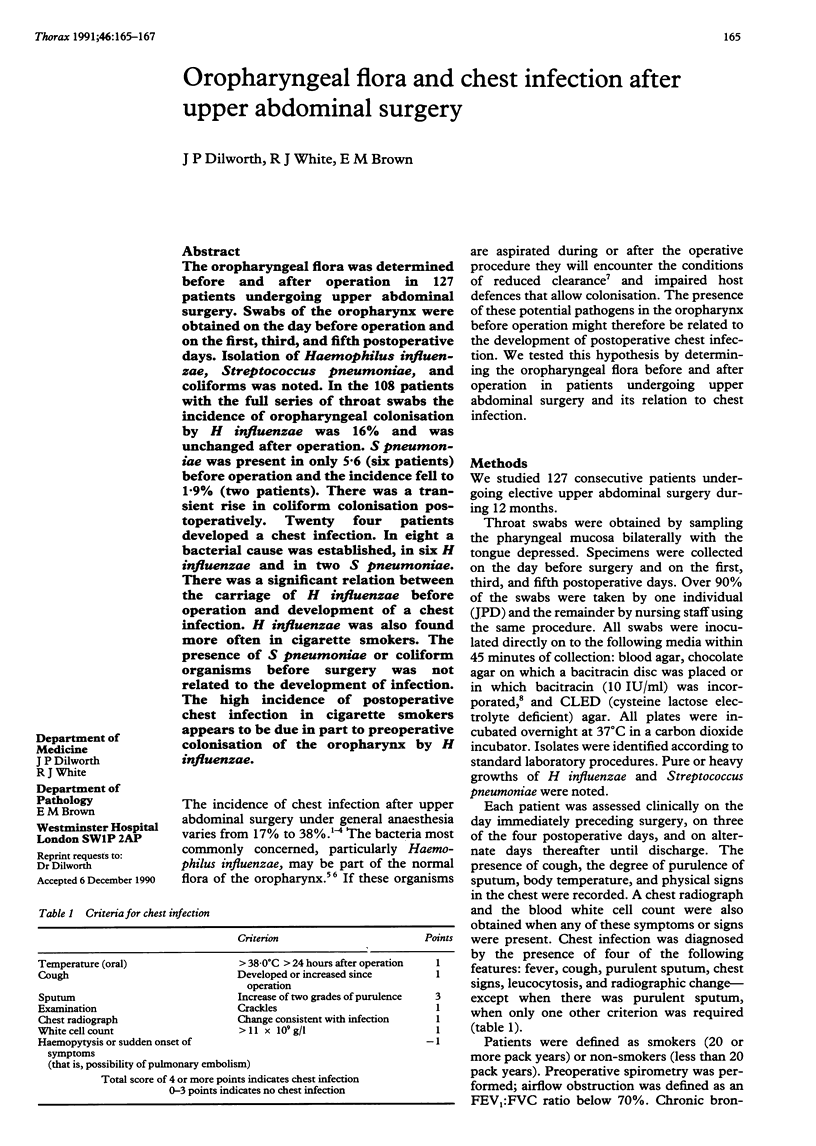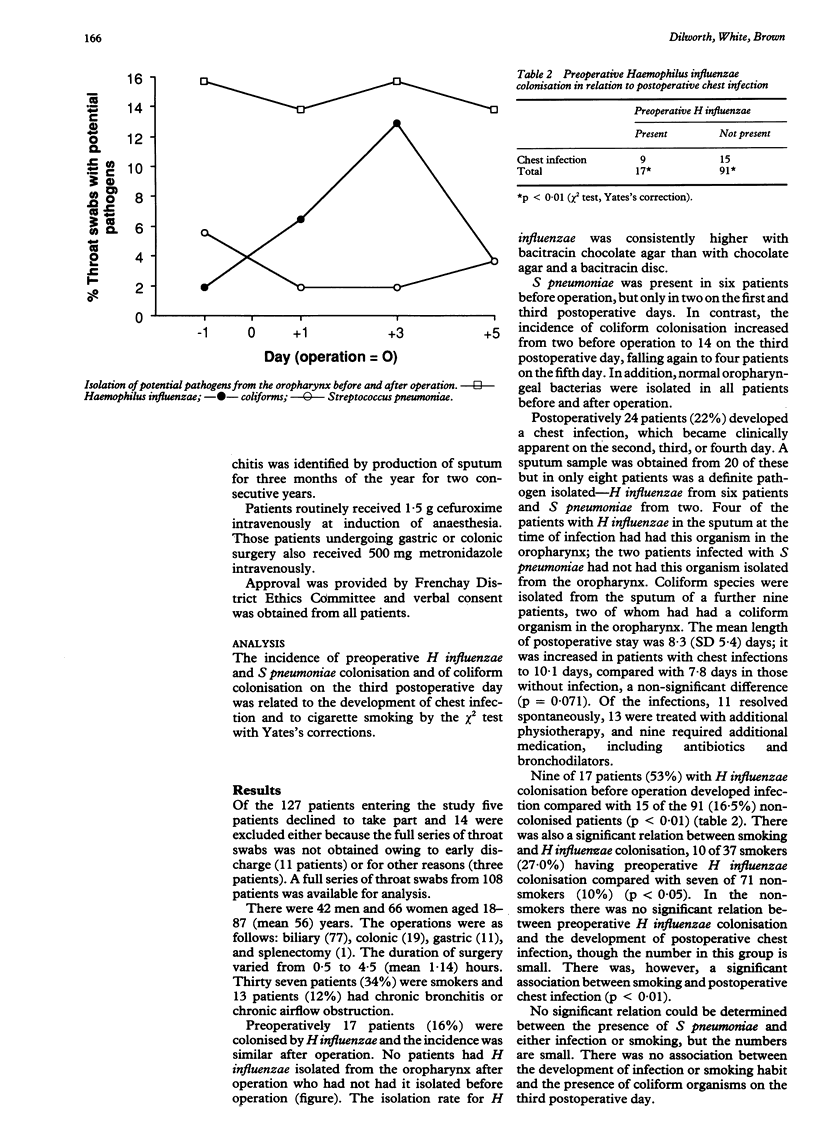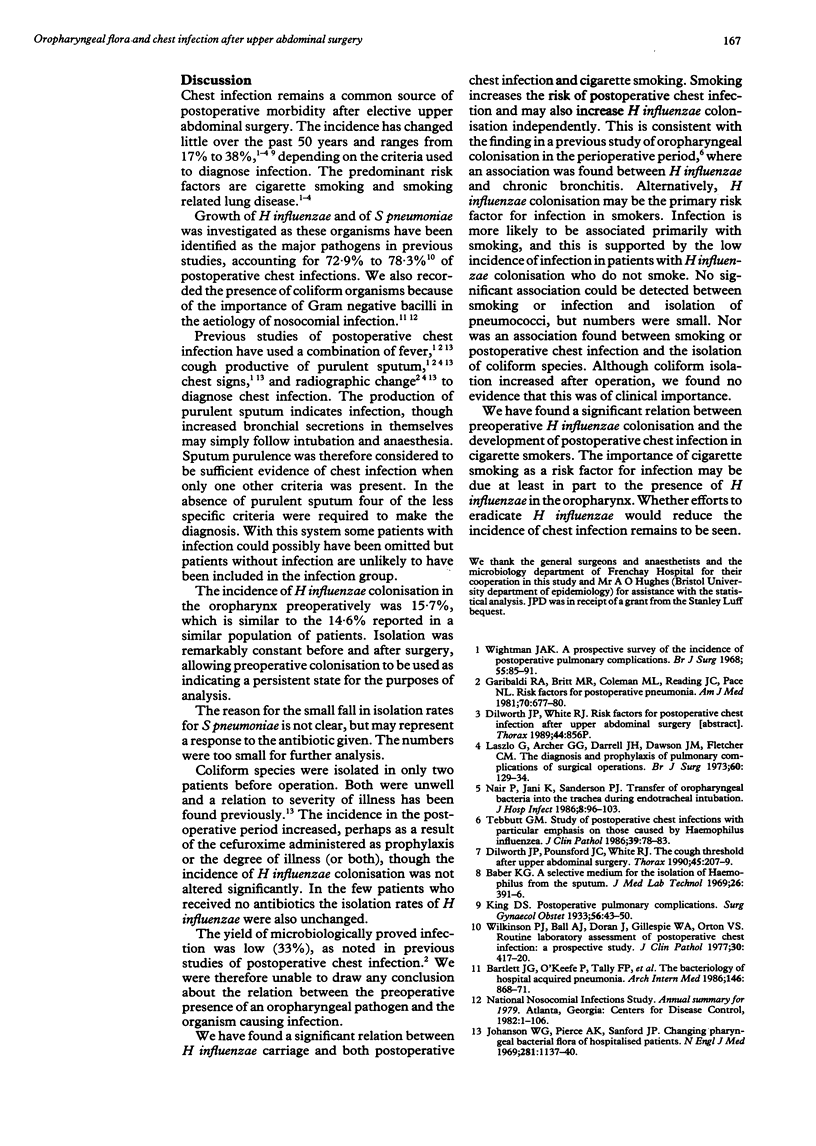Abstract
The oropharyngeal flora was determined before and after operation in 127 patients undergoing upper abdominal surgery. Swabs of the oropharynx were obtained on the day before operation and on the first, third, and fifth postoperative days. Isolation of Haemophilus influenzae, Streptococcus pneumoniae, and coliforms was noted. In the 108 patients with the full series of throat swabs the incidence of oropharyngeal colonisation by H influenzae was 16% and was unchanged after operation. S pneumoniae was present in only 5.6 (six patients) before operation and the incidence fell to 1.9% (two patients). There was a transient rise in coliform colonisation postoperatively. Twenty four patients developed a chest infection. In eight a bacterial cause was established, in six H influenzae and in two S pneumoniae. There was a significant relation between the carriage of H influenzae before operation and development of a chest infection. H influenzae was also found more often in cigarette smokers. The presence of S pneumoniae or coliform organisms before surgery was not related to the development of infection. The high incidence of postoperative chest infection in cigarette smokers appears to be due in part to preoperative colonisation of the oropharynx by H influenzae.
Full text
PDF


Selected References
These references are in PubMed. This may not be the complete list of references from this article.
- Baber K. G. A selective medium for the isolation of haemophilus from sputum. J Med Lab Technol. 1969 Oct;26(4):391–396. [PubMed] [Google Scholar]
- Bartlett J. G., O'Keefe P., Tally F. P., Louie T. J., Gorbach S. L. Bacteriology of hospital-acquired pneumonia. Arch Intern Med. 1986 May;146(5):868–871. [PubMed] [Google Scholar]
- Conway L. W., Collins W. F. Results of trans-sphenoidal cryohypophysectomy for carcinoma of the breast. N Engl J Med. 1969 Jul 3;281(1):1–7. doi: 10.1056/NEJM196907032810101. [DOI] [PubMed] [Google Scholar]
- Dilworth J. P., Pounsford J. C., White R. J. Cough threshold after upper abdominal surgery. Thorax. 1990 Mar;45(3):207–209. doi: 10.1136/thx.45.3.207. [DOI] [PMC free article] [PubMed] [Google Scholar]
- Garibaldi R. A., Britt M. R., Coleman M. L., Reading J. C., Pace N. L. Risk factors for postoperative pneumonia. Am J Med. 1981 Mar;70(3):677–680. doi: 10.1016/0002-9343(81)90595-7. [DOI] [PubMed] [Google Scholar]
- Laszlo G., Archer G. G., Darrell J. H., Dawson J. M., Fletcher C. M. The diagnosis and prophylaxis of pulmonary complications of surgical operation. Br J Surg. 1973 Feb;60(2):129–134. doi: 10.1002/bjs.1800600210. [DOI] [PubMed] [Google Scholar]
- Nair P., Jani K., Sanderson P. J. Transfer of oropharyngeal bacteria into the trachea during endotracheal intubation. J Hosp Infect. 1986 Jul;8(1):96–103. doi: 10.1016/0195-6701(86)90109-x. [DOI] [PubMed] [Google Scholar]
- Tebbutt G. M. Study of postoperative chest infections with particular emphasis on those caused by Haemophilus influenzae. J Clin Pathol. 1986 Jan;39(1):78–83. doi: 10.1136/jcp.39.1.78. [DOI] [PMC free article] [PubMed] [Google Scholar]
- Wightman J. A. A prospective survey of the incidence of postoperative pulmonary complications. Br J Surg. 1968 Feb;55(2):85–91. doi: 10.1002/bjs.1800550202. [DOI] [PubMed] [Google Scholar]
- Wilkinson P. J., Ball A. J., Doran J., Gillespie W. A., Orton V. S. Routine laboratory assessment of postoperative chest infection: a prospective study. J Clin Pathol. 1977 May;30(5):417–420. doi: 10.1136/jcp.30.5.417. [DOI] [PMC free article] [PubMed] [Google Scholar]


